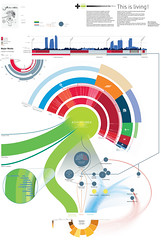The second annual report for international specialist insurer, Hiscox. Some really nice clean clear editorial functioning work simplyfing the complex volume of data for accounts of hiscox. looks very nice in CR the annual may 09. they also have an excellant contrast with some graphs using a nice technique of different shades to reperesent specific groups of data wihtin a bar (..of a bar chart).
http://www.brownsdesign.com/work/?id=67&subcat=&cat=150&i=377&ia=3
found: cr annual 09 may. See also

The city is the subject of the 21st century. All over the
world, populations are shifting towards urban centres. The Endless City
details an authoritative survey of cities now and the prospects for our urban
future. 34 contributors from across Europe, South America, China, Africa and
the U.S. set the agenda for the city – detailing its successes as well as
its failures. the endless city by atelier works below.
Residential Density & Global Connections
Remind of this that I found at http://thesis.armina.info/node/112
very good blog on infographics & annual report by nicholas feltron see also interview.
Abi Huynh- Emily Carr Institute student paper
Woo is the student publication at the Emily Carr Institute of Art, Design and Media. It is funded through the Student’s Union and has a different staff every school year. Based on our proposal our team was chosen to become the editorial board of the paper for the 2006–2007 school year. Each issue of the paper was assembled by a guest editor and guest art director and therefore each has it’s own distinct visual and conceptual direction. One of the first tasks was to define the look and feel of our incarnation of the student paper and subsequently develop a grid system and style guide. The designers for the five issues were:
Easton West,
Anette K Hansen,
Monika Wyndham,
Todd Takahashi,
Ross Milne,
Grace Partridge,
Dan Kim and
Abi Huynh.
Abi Huynh is a graphic designer originally from Lethbridge, Alberta, Canada, currently living in the Netherlands and attending the Koninklijke Academie van Beeldende Kunsten (Den Haag) in the Type and
Media Masters program.
from: http://www.abiabiabi.com/
Browns also did an interesting project for the climate group.
Identity, book, exhibition, guidelines, literature and website for The Climate
Group, a non-profit organisation dedicated to advancing business and
government leadership on climate change. interesting isometric charts and browns museum space to enclose their data for the climate group.
http://www.brownsdesign.com/work/?id=13&subcat=&cat=38&i=314&ia=8



















